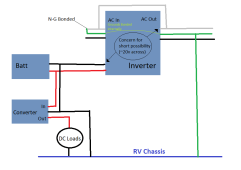Hello all I'm new here and have a question regarding wiring my Growatt SPF 3000TL LVM-48P.
I came across this thread https://diysolarforum.com/threads/growatt-3000-spf-floating-neutral-solved-for-now.31692/ and have determined that my unit does not internally bond neutral and ground and plan to go ahead bond those myself as recommended by the diagrams in that thread.
Now I am wiring this unit up in an RV. In my setup I plan to wire the AC out to the RV's AC breaker panel where the ground bus is connected to the RV chassis. I also want to power the RV's DC circuit's off of the same battery that will power the inverter (through step down to 12v converter). Now as it is the DC circuits also run through the RV's chassis (on the negative side).
I already posted in the original thread here https://diysolarforum.com/threads/growatt-3000-spf-floating-neutral-solved-for-now.31692/post-844617 but this diagram sums up how it would be wired and clarifies my concern.

Does anyone know if this configuration is safe for the unit to connect both the AC ground and in turn neutral (because neutral and ground will be bonded) to RV chassis and DC side battery negative to RV chassis at the same time? In essence, a connection will be created between the inverter's AC neutral out and it's negative DC input terminal through the RV chassis. When testing voltage between these two point I do see about 20v across them, so I am concerned that this configuration will cause short circuit and damage to the unit.
Thanks for any help.
I came across this thread https://diysolarforum.com/threads/growatt-3000-spf-floating-neutral-solved-for-now.31692/ and have determined that my unit does not internally bond neutral and ground and plan to go ahead bond those myself as recommended by the diagrams in that thread.
Now I am wiring this unit up in an RV. In my setup I plan to wire the AC out to the RV's AC breaker panel where the ground bus is connected to the RV chassis. I also want to power the RV's DC circuit's off of the same battery that will power the inverter (through step down to 12v converter). Now as it is the DC circuits also run through the RV's chassis (on the negative side).
I already posted in the original thread here https://diysolarforum.com/threads/growatt-3000-spf-floating-neutral-solved-for-now.31692/post-844617 but this diagram sums up how it would be wired and clarifies my concern.

Does anyone know if this configuration is safe for the unit to connect both the AC ground and in turn neutral (because neutral and ground will be bonded) to RV chassis and DC side battery negative to RV chassis at the same time? In essence, a connection will be created between the inverter's AC neutral out and it's negative DC input terminal through the RV chassis. When testing voltage between these two point I do see about 20v across them, so I am concerned that this configuration will cause short circuit and damage to the unit.
Thanks for any help.


